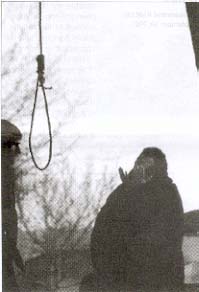September 2001
Iran, A Big Prison for Women
UN reports "no change in the foundational, legalized discrimination faced by women" under the mullahs´ rule
Fariba Tajiani says her last prayers before being hanged in public on March 19, 2001, in East Tehran's impoverished Khaksefid district. This is the Middle Age hanging from the gallow and swinging in the wind. - Paris Match, September 13, 2001 The Iranian regime "is in violation of a number of international standards in terms of the punishments it imposes, some of which can only be characterized as savage."
- UN Human Rights Commission´s Special Representative on Iran
The recent release of the smuggled photographs of a woman being hanged in Tehran, once again brought to the attention of the world the gloomy fate of women who are imprisoned in a big jail, the mullahs' Iran.
The photographs are of Fariba Tajiani Imamgholi, 30, who was hanged on March 19, along with four men, in East Tehran's Khaksefid district. Tajiani was among hundreds of impoverished residents of Khaksefid, arrested on February 22 during a brutal raid by the State Security Forces who razed their homes and subsitence to the ground.
Early morning on March 19, the State Security Forces returned for another show of force. This time, they brought along five former residents of Khaksefid to hang them before the eyes of their neighbors. Fariba was sobbing, begging the judge to forgive her, but to no avail. She was taken up the crane, and moments later, she was no more!
Fariba was one of the first victims of a new wave of terror prevailing Iran and the first woman who was hanged in public, to terrify a weary population growing more disenchanted every day with its oppressive rulers.
This case was also noted by the Special Representative of the UN Human Rights Commission on Iran, whose interim report to the General Assembly was released in early October.
Professor Maurice Danby Copithorne pointed out in his report that theIranian regime "is in violation of a number of international standards in terms of the punishments it imposes, some of which can only be characterized as savage."
Some highlights of his report are as follows:
- The number of executions continues to be high.
- Around two thirds of them were carried out in public... These include the public hanging of a woman on 19 March 2001 in Tehran, an extremely rare event in the Islamic Republic.
- ... It was reported that the state television has broadcast scenes of public hangings on two occasions since the beginning of 2001.
- There have been disturbing reports of resort to especially barbaric and unusual forms of execution, such as beheading and stoning. According to press reports, an Afghan man was publicly decapitated in Zabol in June 2001...
- Since January 2001, the Special Representative has received information concerning the stoning of two women and the sentencing to death by stoning of at least one other.
- ... the Special Representative has recently received reports of the execution of one minor and the sentencing to death of another one.
- The Special Representative continues to receive reports of torture in the legal system, particularly in pre-trial detention.
- There continue to be reports of amputations and public floggings.
- Iran is facing a major economic crisis. Inflation, unemployment and poverty are among the causes of the deteriorating social condition of most Iranians. The human rights cost of the crisis is very high.
- ... the majority of Iranians, in all walks of life, believe that at the beginning of the twenty-first century, they deserve better and more accountable governance and a society that has more respect for the inherent dignity of individuals.
Status of women
- The status of women, particularly their legal status, remains highly discriminatory.
- Patriarchal attitudes are very much in evidence in the form of domestic violence and the limited prospects for women to enter the labour force.
- A member of the Women's Participation Centre in Tehran was quoted recently as saying that women had become more frequently the victims of beatings, rape, abortions, financial and mental pressures, and verbal abuse from their husbands, brothers and even children.
- Another side of women's plight is what has become known as the "feminine face of poverty".
- Finally, there is the long outstanding benchmark issue of the minimum age of marriage, particularly that for girls, which is nine years.
- In February, a girl's shelter in Karaj, the Jasmine Centre, was closed down after an investigation had reportedly revealed that it had become involved in the trafficking of girls. The press focused on the high-level connections of the operators of the Centre. A judge of the Revolutionary Court was subsequently charged in the affair.
- The condition of women in the Islamic Republic has remained much the same for some years: steady improvements in some respects such as education but no change in the foundational, legalized discrimination faced by women almost across the board.
- Perhaps the most graphic recent portrayal of this situation is the Iranian film, "The Circle", with its strong overtones of the Islamic Republic as a prison for women.
- The Special Representative's conclusion is that despite the evident desire of the Iranian people to improve the legal status of women, the stalemate between the branches of government on the very limited measures that have so far been proposed must leave the Islamic Republic, as a country, in an extremely embarrassing position.
From The Monthly Bulletin of the Women´s Committee of the National Council of Resistance of Iran, 17, Rue des Gords, 95430 Auvers-sur-Oise, France, e-mail:
Til forsiden / Back to front
Epost:
http://www.peacelink.nu



